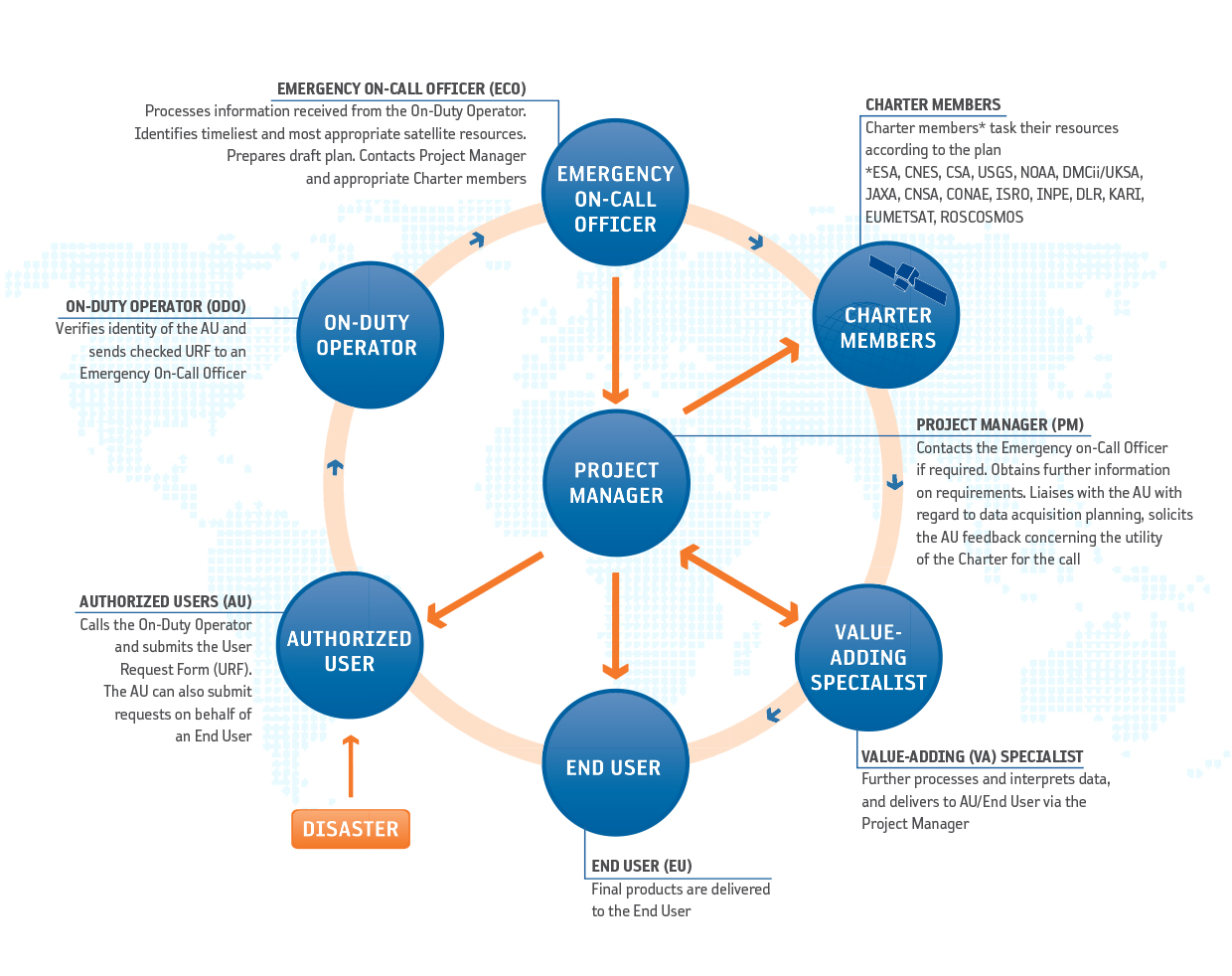There are several mechanisms to activate the Charter. It is based on a pre-defined list of appointed users, known as 'Authorized Users' (AUs). Until now AUs are typically disaster management authorities, from countries of Charter member agencies, able to request Charter support for emergencies in their own country, or in a country with which they cooperate for disaster relief.
Since its inception, the Charter has demonstrated a strong commitment to expanding its number of users. Initiatives include collaboration with UNITAR/UNOSAT and UN OOSA, active in many countries and who can submit requests to support in-country UN relief agencies, and Sentinel Asia, a regional network for Earth observation-based Emergency Response in 32 countries.
Universal Access
Building on a decade of success in making satellite data available for disaster response, the International Charter is now opening its doors even wider. The Charter Members have adopted the principle of Universal Access to further strengthen the Charter's contribution to disaster management worldwide. Any national disaster management authority will be able to submit requests to the Charter for emergency response. Proper procedures will have to be followed, but the affected country will not have to be a Charter member.Universal Access benefits national disaster management authorities in countries beyond those of the Charter members, previously unable to make direct requests to the Charter.
A registration process is in place for national authorities interested in participating in the Charter as an "Authorized User". This process will validate the ability of national authorities to access and use Charter assets for disaster response, in accordance with Charter operational procedures. Steps and applicable conditions are explained in the Charter's Universal Access Information Brochure available together with its Registration form.
Map showing countries (in dark blue) with direct access to the Charter in July 2016. Universal Access allows national users from new countries to directly submit emergency requests as Authorized Users. In addition the Charter collaborates with Sentinel Asia, a regional network for Earth observation-based Emergency response in 26 countries (87 national organisations) and 15 International Organizations, and with UNITAR/UNOSAT and UNOOSA, active in many countries and who can submit requests to support in-country relief agencies of the United Nations. All countries of the world can benefit from the Charter by any of the ways described above. Since 2000 there have been 499 disasters covered in 118 countries worldwide.
Sequence of Events
The following illustration depicts the sequence of events that occur once the Charter is activated. Beginning with the authorized user (bottom left), follow the sequence with your mouse for a brief description of each step, and click on any of the steps for more in-depth information.An Authorized User can call a single number to request the mobilization of the space and associated ground resources associated with Charter members in order to obtain data and information on a disaster occurrence.
A 24-hour on-duty operator receives the call, checks the identity of the requestor and verifies that the User Request form, sent by the Authorized User, is correctly completed.
The operator passes the information to an Emergency On-Call Officer who analyzes the request and the scope of the disaster with the Authorized User, and prepares an archive and acquisition plan using available satellite resources.
Data acquisition and delivery takes place on an emergency basis, and a Project Manager, who is qualified in data ordering, handling and application, assists the user throughout the process.
Charter Operational Loop

Mechanisms to activate the Charter
There are several mechanisms for a user organisation to submit a request to activate the Charter:Direct activation
A pre-defined list of appointed users, known as 'Authorized Users' (AUs), can submit a request for a disaster occurring in their country. The only bodies authorised to directly request the Charter to be activated are the AUs (typically civil protection agencies, governmental relief organisations, or other authorities with a mandate related to disaster management).Activation via an Authorised User on behalf of a user from a non-member country ('sponsor Authorised User')
Authorised Users can access the Charter to request support for a disaster in a country with which they cooperate for relief purposes.Activation via the UN for UN users
The Charter has an agreement with UN OOSA (Vienna) and UNITAR/UNOSAT (Geneva) to provide support to UN agencies. UN OOSA and UNITAR/UNOSAT may submit requests on behalf of users from the United Nations.Activation for Asia Pacific users via Sentinel Asia's partner, the Asian Disaster Reduction Centre
Sentinel Asia is a regional collaboration for Earth observation based emergency response in 31 Asia Pacific countries.Since 2009 the Charter has granted the Asian Disaster Reduction Centre the right to submit activation requests on behalf of national users of Sentinel Asia.
Further actions to improve Charter access with GEO
In response to a request from the Group on Earth Observation (GEO) to improve access to the Charter during emergencies, collaboration has started with primary focus on users from African countries that do not have a direct access to the Charter. In 2009, the Charter initiated a formal user consultation to address the improvement of Charter access in African countries.Universal Access Information Brochure & User Registration Form
Emergency related enquiries
New users without direct access to the Charter should address emergency related enquiries to:executivesecretariat@disasterscharter.org
General information enquiries
General enquiries concerning the Charter operations and provisions should be addressed to:webmaster@disasterscharter.org

Keine Kommentare:
Kommentar veröffentlichen